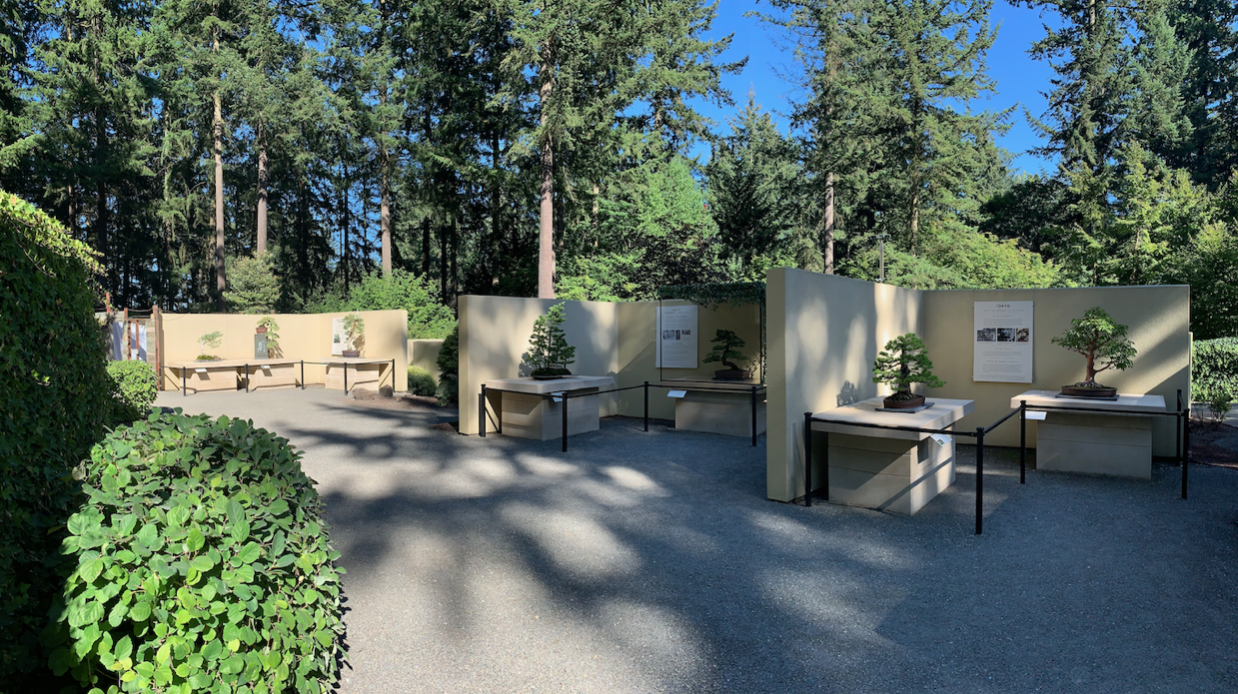PBM’s exhibit, World War Bonsai: Remembrance and Resilience, on view through October 2021 Photos: Aarin Packard
Many of the National Bonsai & Penjing Museum’s staff members have gone on to establish a great bonsai legacy for themselves. For this edition of Bonsai Around the World, we detail the Pacific Bonsai Museum through an interview with Aarin Packard, one of our former assistant curators who now leads PBM as curator.
Packard grew up in Southern California, forging a connection to nature while gardening with his parents on the weekends and watching his father work on bonsai in the backyard. He always held an appreciation for miniatures, like scale models, as well as Asian culture, particularly martial arts. Packard, however, only became interested in bonsai after several of his friends began the practice.
He started after buying a tree from the Orange County swap meet and tended to it as a hobby while studying anthropology at California State University, Fullerton. Packard read about the art and visited local nurseries and club shows. He started pursuing bonsai as a career after moving to D.C. to get his master’s in museum studies at The George Washington University and coming across the National Bonsai & Penjing Museum.
“On my first day as a resident in the District, I went to the U.S. National Arboretum and stopped at the bonsai museum,” he said. “Michael James was the assistant curator at the time, and I asked him, ‘How do I get your job?’”
In February 2006, Packard graduated from GW and was selected as the assistant curator for the Museum, a position he served until 2014. The year before Packard left the Museum, the Weyerhaeuser Company – one of the largest North American timber companies – donated its entire bonsai collection to a new nonprofit, The George Weyerhaeuser Pacific Rim Bonsai Collection, or the “Pacific Bonsai Museum.”
The nonprofit was looking for a curator, which Packard saw as a great opportunity to return home to the West Coast while heading the privately run but public collection. He was hired to use his museum studies background to curate exhibits for the new collection and lead tree care efforts.
“I was given the opportunity to create a vision for what this Museum could be,” he said. “I kind of had a blank slate to do what I wanted, so it was exciting to have that creative freedom to progress in my career, and it’s been really enjoyable.”
Rather than separating their trees into different collections, the museum displays a museum-wide exhibit each year with trees that pertain to the exhibit’s theme. The current exhibition is “World War Bonsai,” an idea Packard has been forming since working with bonsai artists and trees with intrinsic ties to World War II, like the Yamaki Pine.
“I’ve been amassing research on this era throughout my career, and with last year being the 75th anniversary of the end of World War II, I felt like it was an appropriate time to investigate the stories of bonsai and people within our collection that have a relationship with that time,” Packard said.
Alcove depicting the scene when 120,000 Japanese Americans were forced to board trains and travel to live in barbed-wire detention camps displayed with a Bristlecone Pine bonsai originally created by Kelly Hiromo Nishitani
The exhibition primarily focuses on the incarceration of Japanese Americans during the war and how the years of fighting affected the art of bonsai both in the United States and Japan.
“It’s been a well-received exhibit,” Packard said. “The exhibit sheds light on the cost of war on the art of bonsai and how it provided people in hard situations comfort and connection to cultural communities and extensions of self.”
The museum's exhibits incorporate work from contemporary artists that connect the theme of the display to current events. World War Bonsai features an installation from a Seattle-based Japanese American artist who draws parallels from Japanese incarceration to current racial inequities in the United States.
“That’s one thing bonsai has the ability to do – the art is not just limited to cute little trees and someone’s gardening curiosity,” Packard said. “Bonsai are objects of significance that have a lot of resonance and can tell stories that haven’t been told before.”
Though the museum’s trees are displayed in an open-air gallery, the bonsai are still protected in the winter with their own small, cube-like greenhouses that are removed in the spring. About 60 trees are displayed at a time among the museum’s alcoves and benches, but Packard moves the bonsai around depending on the year’s exhibit. The museum’s tropical trees remain in a special conservatory throughout the year to keep them safe from the elements.
Left: Aarin pruning the domoto maple; Right: Domoto maple (in training since 1850) in colorful, leafy state
A 9-foot-tall trident maple from the Domoto family is what Packard calls the museum’s “crown jewel.” The Domoto maple is one of the oldest bonsai in the United States, imported from Japan for the Panama Pacific International Exposition in San Francisco in 1913.
Kanetaro Domoto, a Japanese immigrant who ran one of the largest commercial nurseries in California, bought the maple after the fair, and it was the only possession the family didn’t lose during the Great Depression. The tree survived alone during the incarceration period of World War II, but upon their release from captivity Domoto’s son found and cared for it until 1990, when he loaned it to the Weyerhaeuser collection. His descendants eventually donated the tree outright to the museum.
“The maple tells the story of bonsai in the United States and the Japanese American immigrant experience,” Packard said. “Just to think of the story of this tree and how it survived hardships is kind of the flipside of bonsai during the era and is very rare to see.”
Learn more about the Pacific Bonsai Museum and its beautiful exhibits here.




